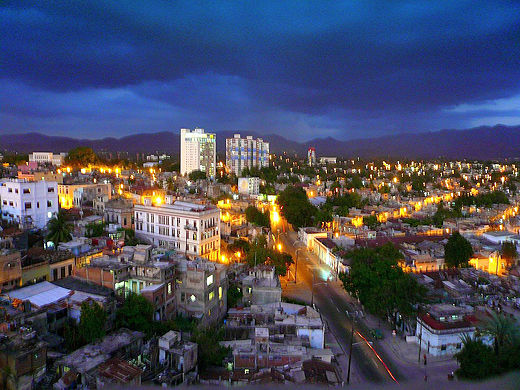
Santiago de Cuba is the second largest city of Cuba and capital of Santiago de Cuba Province in the south-east of the island, some 540 miles from the national capital of Havana. It was founded by Spanish conquistador Diego Velázquez de Cuéllar on July 25, 1515.
The municipality extends over 395 square miles on a bay connected to the Caribbean Sea and is a vital port. Its population surpasses half a million.
Santiago was the starting point of the expeditions led by Juan de Grijalba and Hernán Cortés to Mexico in 1518, and in 1538 by Hernando de Soto’s voyage to Florida. The first cathedral was built in Santiago in 1528. From 1522 until 1589 it was the capital of the Spanish colony of Cuba.
Santiago saw an influx of French and British immigrants in the late 18th and early 19th centuries, many coming from Haiti after the Haitian slave revolt of 1791. This added to the city’s eclectic cultural mix, already rich with Spanish and African, and some remnants of indigenous culture.
Here Spanish troops faced their defeat at San Juan Hill on July 1, 1898, during the Cuban-Spanish-American War. Spain surrendered to the U.S. after the Americans destroyed the Spanish Atlantic fleet just outside Santiago’s harbor on July 3, 1898.
Role in revolution
Cuban poet, writer, and national hero, José Martí, is buried in Cementerio Santa Efigenia in Santiago, which was also the home of the revolutionary hero Frank País. On July 26, 1953, the Cuban Revolution began with an armed attack on the Moncada Barracks by a small contingent of rebels led by Fidel Castro. Shortly after this incident, País began talking with students and young working people informally, drawing around him what became an effective urban revolutionary alliance. This developed into highly organized groups coordinating a large scale urban resistance that became instrumental in the success of the Revolution.
País’s group amassed weapons and collected both money and medical supplies. They published a newsletter criticizing the government, attempting to counter Batista’s censorship. In the summer of 1955, País’ organization merged with Fidel’s July 26 Movement. País became the leader of the new organization in Oriente province, but two years later he was betrayed to the police and was shot after his capture.
On January 1, 1959, Fidel Castro proclaimed the victory of the Cuban Revolution from a balcony on Santiago de Cuba’s city hall. From there the Santiago contingent of the guerrilla army marched across Cuba, reaching Havana about a week later.
Culture in Santiago de Cuba
Santiago de Cuba was the hometown of poet José María Heredia. It houses a museum that displays the extensive art collection of the Bacardí rum-making family.
Santiago is well known for its cultural life. Some of Cuba’s most famous musicians, including Compay Segundo, Ibrahim Ferrer and Elíades Ochoa (all of them in the Buena Vista Social Club), and trova composer Ñico Saquito (Benito Antonio Fernández Ortiz) were born in the city or surrounding villages.
Furthermore, Santiago is well known for its traditional dances, most notably son, from which salsa is derived, and guaguancó, which is accompanied by percussion music only. The city is also famous for its Carnival, which is strangely enough celebrated in July. During Carnival, traditional conga music is played in the streets on a traditional pentatonic trumpet, called the trompeta china.
A relatively high number of residents of the city adhere to Afro-Cuban religions, most notably santería. Some aspects of the religious “vodún” heritage of the city can be traced back to the Haitian immigrant community from the 19th century.
Santiago features multiple architectural styles, from Baroque to neoclassical and contemporary. Of special interest are the wooded parks, the steep streets, colonial buildings with huge windows and crowded balconies. Preserved historical treasures include the first home in the Americas, the first cathedral in Cuba, the first copper mine opened in the Americas, and the first Cuban museum.
The local citadel of San Pedro de la Roca is inscribed on the UNESCO World Heritage List as “the most complete, best-preserved example of Spanish-American military architecture, based on Italian and Renaissance design principles.” Baconao Park, about 40 miles from Santiago, is inscribed on the UNESCO World Heritage Biosphere Reserve List.
Santiago de Cuba is a sister city of Oakland, Calif.
Worth a visit, wouldn’t you say?
Adapted from Wikipedia and other sources.
Photo: View of Santiago de Cuba and sky at night, March 11, 2011. Alex Cano, licensed under the Creative Commons Attribution-Share Alike 4.0 International.







